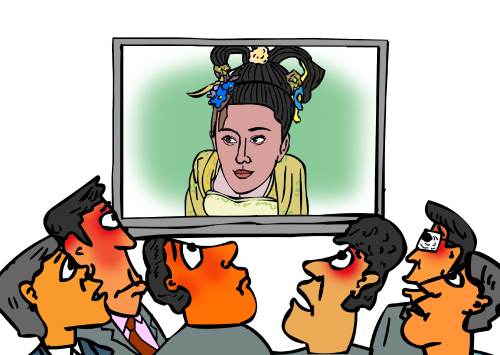 |
|
(LI SHIGONG) |
A heated discussion was sparked when popular TV drama The Saga of Empress Wu Zetian, a semi-biographical account of the only female emperor in Chinese history, was taken off the air temporarily. In the original version, most actresses, be they concubines or court maids, were attired in low-cut costumes that invariably revealed cleavage. When the series surprised broadcasting recently, viewers were stunned to find that most scenes showing women from the neck down had been cropped. All one now sees is close-ups of females' faces as they speak, so that their cleavage is out of shot.
Thus far, there has been no official explanation of the edits. Sources said they were likely carried out because too much of the actresses' cleavage was on display. This has enraged some TV fans. Some have argued that this is how women dressed in the Tang Dynasty (618-907), when Wu lived, and that post-production changes show no respect for history. Others support the editing, and argue that showing too much cleavage would have a negative influence on younger audiences since no rating system for TV programs is currently in place in China. Meanwhile, those discontented with the country's censorship have taken this opportunity to voice their long-held grievances.
Doing justice to history
Yin Jianguang (www.iqilu.com): The edited version of the drama has now become a laughing stock among audiences. People were initially shocked by the candid nature of the series--the dresses worn by female characters are low-cut to the degree that cleavage is distractingly prominent. TV producers should in the first instance work with a more responsible attitude toward history and the audience. The audience is not easily fooled.
Indeed, it is true the Tang Dynasty is widely recognized as having been an open society in many aspects, but this does not necessarily mean that all women at that time deliberately wore low-cut attire to expose their cleavage. At that time, low-cut dresses were most likely to be seen in women's boudoirs, not in everyday life as is suggested in the drama. Instead of focusing on "attracting the audience's eyeballs," TV program producers have a lot to learn about the culture of dress in the Tang Dynasty.
Fan Lingzhi (www.huanqiu.com): How exactly did females in the Tang Dynasty dress? And does the attire seen in this drama conform to historical reality?
Zhang Guogang, a professor with Tsinghua University who is also an expert on the history of the Tang Dynasty, said Tang-style attire absorbed many of the elements native to costumes worn by ethnic minorities of the period. These elements, however, did not include plunging necklines, but items of clothing such as jackets which are still worn today. Murals handed down show that women's costumes do reveal their necks, but there is no clear indication of cleavage being displayed. Owing to the highly developed economy and culture of the Tang Dynasty, women, particularly noblewomen, wore low-cut formal dresses with large sleeves, but not on all occasions. Thus, the omnipresence of low-cut dresses we originally saw in the drama is exaggerated, and this kind of irresponsible embellishment of people's lifestyles in ancient times not only deviates from the reality of that era, but misleads the audience.
Xiao Taiyang (www.people.com.cn): The drama threw reviewers into a quandary. Should they cut, they would be blamed for mutilating the drama's many beautiful scenes, while were they to choose not to do so, they would be criticized for allowing a negative influence to be exerted over younger generations of TV watchers.
A lot of well-preserved portraits of ladies from the Tang Dynasty clearly indicate that although some costumes are in a low-cut style, no evidence exists that ladies at that time showed cleavage. Nowadays, it seems that the audience ratings to a large extent depend on females wearing sexy clothes and even the inclusion of obscene content. In the name of respecting the history of the Tang Dynasty, the social atmosphere of which was more open than other dynasties in Chinese history, TV drama producers are arguably destroying the gracefulness and real beauty of this era through the superimposing of modern tropes onto ancient figures. The post editing is more or less disregarding the original gorgeousness of this historical saga. This represents a loss for both TV producers and audiences.
